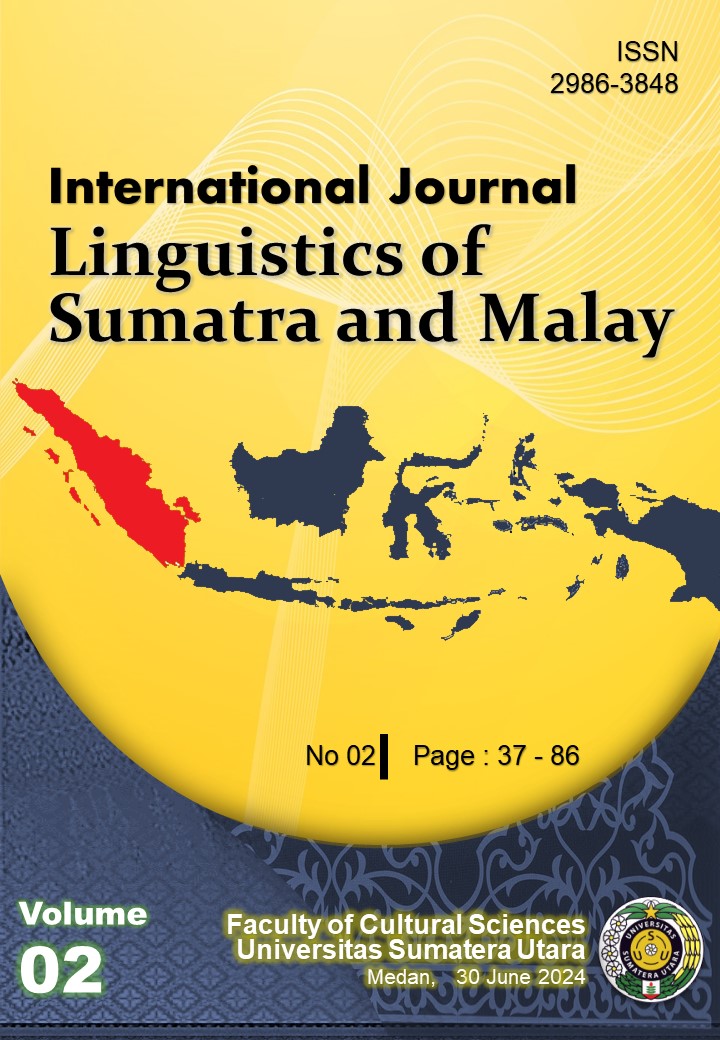Enhancing Augmented Reality (AR) Technology to Improve Medical English Literacy
DOI:
https://doi.org/10.32734/ijlsm.v2i2.17082Keywords:
Augmented Reality, Nursing Students, Multimodal Literacy, Medical EnglishAbstract
Since the paradigm for teaching reading has shifted from traditional literacy to multimodal literacy, prior research has demonstrated that augmented reality (AR) technology can successfully improve conventional literacy in general language learning. Only a few research, particularly in English for Nurse courses, have examined the potential of Augmented Reality (AR) technology to improve multimodal literacy in ESP learning. The purpose of this study was to determine how AR technology affects nursing students' multimodal literacy in ESP learning and how they communicate with others through a variety of multimodal modalities to improve their multimodal literacy in medical English. Fifty nursing students enrolled in English for Nursing courses participated in the study to share their experiences using this multimodal ESP learning survey to improve their medical English literacy. In the auditory mode, background music and sound effects were used to elicit strong emotions and improve immersive experiences. The results also showed a significant improvement in nursing students' multimodal English literacy skills when the material was created for a location-based augmented reality application. The findings revealed that nursing students used three modes in AR (visual, imaging, and animations). The three modes were used to help viewers comprehend complex material, give them specific ideas, and encourage participation.
Downloads
References
Akçayır, M., & Akçayır, G. (2017). Advantages and challenges associated with augmented reality for education: A systematic review of the literature. Educational Research Review, 20(1), 1–11. https://doi.org/10.1016/j.edurev.2016.11.002
Alalwan, N., Cheng, L., Al-Samarraie, H., Yousef, R., Ibrahim Alzahrani, A., & Sarsam, S. M. (2020). Challenges and Prospects of Virtual Reality and Augmented Reality Utilization among Primary School Teachers: A Developing Country Perspective. Studies in Educational Evaluation, 66(March), 100876. https://doi.org/10.1016/j.stueduc.2020.100876
Ariano, R., Manca, M., Paternò, F., & Santoro, C. (2023). Smartphone-based augmented reality for end-user creation of home automations. Behaviour and Information Technology, 42(1), 124–140. https://doi.org/10.1080/0144929X.2021.2017482
Billinghurst, M., & Dunser, A. (2012). Vocational Training Council Note. Augmented Reality in the Classroom, 56–63.
Challenor, J., & Ma, M. (2019). A review of augmented reality applications for history education and heritage visualisation. Multimodal Technologies and Interaction, 3(2). https://doi.org/10.3390/mti3020039
Che Dalim, C. S., Sunar, M. S., Dey, A., & Billinghurst, M. (2020). Using augmented reality with speech input for non-native children’s language learning. International Journal of Human Computer Studies, 134(September 2019), 44–64. https://doi.org/10.1016/j.ijhcs.2019.10.002
Chen, M. P., Wang, L. C., Zou, D., Lin, S. Y., Xie, H., & Tsai, C. C. (2022). Effects of captions and English proficiency on learning effectiveness, motivation and attitude in augmented-reality-enhanced theme-based contextualized EFL learning. Computer Assisted Language Learning, 35(3), 381–411. https://doi.org/10.1080/09588221.2019.1704787
Chen, X., Zou, D., Cheng, G., & Xie, H. (2020). Detecting latent topics and trends in educational technologies over four decades using structural topic modeling: A retrospective of all volumes of Computers & Education. Computers and Education, 151(February), 103855. https://doi.org/10.1016/j.compedu.2020.103855
Cheng, Y. W., Wang, Y., Cheng, I. L., & Chen, N. S. (2019). An in-depth analysis of the interaction transitions in a collaborative Augmented Reality-based mathematic game. Interactive Learning Environments, 27(5–6), 782–796. https://doi.org/10.1080/10494820.2019.1610448
Crompton, H., Bernacki, M., & Greene, J. A. (2020). Psychological foundations of emerging technologies for teaching and learning in higher education. Current Opinion in Psychology, 36, 101–105. https://doi.org/10.1016/j.copsyc.2020.04.011
Davis, N. L., Gough, M., & Taylor, L. L. (2019). Online teaching: advantages, obstacles and tools for getting it right. Journal of Teaching in Travel and Tourism, 19(3), 256–263. https://doi.org/10.1080/15313220.2019.1612313
Elmqaddem, N. (2019). Augmented Reality and Virtual Reality in education. Myth or reality? International Journal of Emerging Technologies in Learning, 14(3), 234–242. https://doi.org/10.3991/ijet.v14i03.9289
Finch, K., Theakston, A., & Serratrice, L. (2020). Teaching modern foreign languages in multilingual classrooms: an examination of Key Stage 2 teachers’ experiences. Language Learning Journal, 48(5), 628–642. https://doi.org/10.1080/09571736.2018.1448432
Garzón, J. (2021). An overview of twenty-five years of augmented reality in education. Multimodal Technologies and Interaction, 5(7), 1–14. https://doi.org/10.3390/mti5070037
Garzón, J., Kinshuk, Baldiris, S., Gutiérrez, J., & Pavón, J. (2020a). How do pedagogical approaches affect the impact of augmented reality on education? A meta-analysis and research synthesis. Educational Research Review, 31(2), 100334. https://doi.org/10.1016/j.edurev.2020.100334
Garzón, J., Kinshuk, Baldiris, S., Gutiérrez, J., & Pavón, J. (2020b). How do pedagogical approaches affect the impact of augmented reality on education? A meta-analysis and research synthesis. Educational Research Review, 31(July 2019), 100334. https://doi.org/10.1016/j.edurev.2020.100334
Larchen Costuchen, A., Darling, S., & Uytman, C. (2021). Augmented reality and visuospatial bootstrapping for second-language vocabulary recall. Innovation in Language Learning and Teaching, 15(4), 352–363. https://doi.org/10.1080/17501229.2020.1806848
Lin, V., Liu, G. Z., & Chen, N. S. (2022). The effects of an augmented-reality ubiquitous writing application: a comparative pilot project for enhancing EFL writing instruction. Computer Assisted Language Learning, 35(5–6), 989–1030. https://doi.org/10.1080/09588221.2020.1770291
López-Belmonte, J., Moreno-Guerrero, A. J., López-Núñez, J. A., & Hinojo-Lucena, F. J. (2020). Augmented reality in education. A scientific mapping in Web of Science. Interactive Learning Environments, 0(0), 1–15. https://doi.org/10.1080/10494820.2020.1859546
Parmaxi, A., & Demetriou, A. A. (2020). Augmented reality in language learning: A state-of-the-art review of 2014–2019. Journal of Computer Assisted Learning, 36(6), 861–875. https://doi.org/10.1111/jcal.12486
Wedyan, M., Falah, J., Elshaweesh, O., Alfalah, S. F. M., & Alazab, M. (2022). Augmented Reality-Based English Language Learning: Importance and State of the Art. Electronics (Switzerland), 11(17), 1–17. https://doi.org/10.3390/electronics11172692
Wu, H. K., Lee, S. W. Y., Chang, H. Y., & Liang, J. C. (2013). Current status, opportunities and challenges of augmented reality in education. Computers and Education, 62(2), 41–49. https://doi.org/10.1016/j.compedu.2012.10.024
Yang, S., & Mei, B. (2018). Understanding learners’ use of augmented reality in language learning: insights from a case study. Journal of Education for Teaching, 44(4), 511–513. https://doi.org/10.1080/02607476.2018.1450937
Downloads
Published
Issue
Section
License
Copyright (c) 2024 International Journal Linguistics of Sumatra and Malay

This work is licensed under a Creative Commons Attribution-ShareAlike 4.0 International License.
All articles published in the International Journal Linguistics of Sumatra and Malay (IJLSM) are licensed under the Creative Commons Attribution-ShareAlike 4.0 International License (CC BY-SA 4.0).
This license permits anyone to:
-
Share — copy and redistribute the material in any medium or format.
-
Adapt — remix, transform, and build upon the material for any purpose, even commercially.









